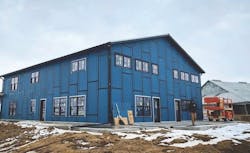Kyle Stumpenhorst: From Builder to Influencer
Key Highlights
- Kyle Stumpenhorst has amassed millions of followers on TikTok, Instagram, and YouTube by sharing his construction projects and educational content.
- His background in computer science helped him approach construction with a problem-solving mindset, learning through trial and error and social media inspiration.
- He emphasizes the importance of hard work and delayed gratification to attract more young people to the trades and address industry workforce shortages.
- Kyle aims to inspire the next generation of tradespeople and promote the advantages of post-frame construction, including cost savings and energy efficiency.
Kyle Stumpenhorst is the founder and owner of Rural Renovators, a custom post-frame construction company in Franklin Grove, Ill.
And while his hometown and local market about 100 miles west of Chicago are exceptionally small, with a population of fewer than a thousand souls, that hasn’t kept him from amassing an audience numbering in the millions online.
In fact, he has 1.8 million followers on TikTok, more than 500,000 followers on Instagram, and just over 1 million YouTube subscribers to his channel, @RR Buildings, where he uses his latest custom post-frame projects to provide informational, educational content to fellow home builders and contractors.
Stumpenhorst believes social media can be a gold mine of information for tradespeople of all experience levels, as well as an entry point for more young people to join the construction workforce. As the building sector looks to hire 650,000 additional skilled workers in 2022, according to data from Associated Builders and Contractors, it’s social media channels like Stumpenhorst’s that offer the building blocks for promoting the industry and educating its workers.
Custom Builder: Did you always know you wanted to work in construction?
Kyle Stumpenhorst: No, not at all. I actually went to school for computer science and was going to get into the IT field. But I did that for a couple of years and didn’t like it. I didn’t like the grind of going to work day to day, every day, same time, same place, same route, same office, and instead fell in love with working with my hands. So I opted to make the move to construction work.
CB: How did you get started as an influencer and what role do you think social media plays as a catalyst in educating the industry?
KS: Education was the main reason why I got started [in 2012, on YouTube] because I needed to find a way to educate clients and potential clients about what sets Rural Renovators apart as a builder. I wanted to show clients the products we offer and why they should use us versus some of the other big names. I needed to prove we were worth hiring.
In the small community where I live, word of mouth was the original “social media,” but with today’s online channels, you can tell the story however you want and you can share the jobs you’re most proud of instead of relying on what other people are saying about you.
Social media also lets you break down content so it’s as detailed or as high level as you want, allowing you to hit different niche audiences.
Post-frame construction is our specialty, and it’s not something the whole country or even the whole world knows a lot about. I think that’s why the YouTube channel grew so much. I really showed the detail and process of building post frames from start to finish.
CB: Since your background is in computer science, how did you gain building knowledge?
KS: It was a lot of trial and error. I had a technical background from problem-solving in mathematics, so it was easier for me to look at the end result and break it down to figure out how I was going to get there. I remodeled my own home and learned a lot about what not to do in the process, so I didn’t have to mess it up for my clients.
Even so, I don’t know it all now and I’m constantly looking for new ways to do things. That’s why I love social media because I’ll see a picture of something and it will click in my brain as to how I can implement that on my jobsites to make our process smoother or better.
"If you want to be proud of what you’re doing...working in the trades is a really good way to do that."
- Kyle Stumpenhorst
CB: How do you hope to foster more interest in the building industry and grow the skilled construction workforce?
KS: Industrywide, there will always be bad days, but my goal is to highlight the positives of being in the trades.
The ability to look at what you’ve done at the end of the day and feel good about the hard work that went into it is an important message because this isn’t an easy job. There’s a lot of hard work involved, and there are a lot of people who are afraid of hard work.
Some people may prefer to take the easy course, but it’s not always as gratifying to do what’s easy. So I try to share that; that delayed gratification is important. And that if you want to be proud of what you’re doing, then working in the trades is a really good way to do that. In terms of quantitative, tangible work, it’s something you actually can put your hands on and can see.
CB: Are the resources offered through your content geared toward experienced builders or can a beginner follow along and learn from it?
KS: I do a little bit of everything. I’ll showcase high-level projects, but I’ll also dive deep into the actual math behind it and the process I use to get from point A to point B. So, whether you’re a DIY builder or a professional who maybe hasn’t done this sort of thing before, you can follow along and figure it out. That’s the beauty of social media.
The trades, in general, lack a lot of educational resources—not just because our trade schools have been taken away, but because most tradespeople are working for either an owner/operator or are an owner/operator themselves. They’re not working for some big union or large company, and therefore, their education is limited to what that individual has taught them or what they’ve learned on the jobsite themselves. It’s a learning process that’s not necessarily good for the industry.
I think social media has created a place for people like me and other pros who have worked hard to master their craft to share that experience with those eager to learn. It provides a centralized location from which people can pick and choose what they want to learn from all of the different accounts and individuals they may follow.
CB: Is the community of builders and tradespeople on social media growing?
KS: The trades historically have been a very closed community; those with trade secrets or great tips generally didn’t share information with their local competition. A lot of builders and business owners keep their cards close to their chests. But social media isn’t really competition. It’s more about sharing what you know to hopefully help other people.
In the end, it’s been helpful for the entire building community to be able to educate someone from Day One.
CB: Is this type of educational content becoming a powerful tool to attract new workers?
KS: Definitely. A new worker coming into the trades can scour the internet and different social media platforms to learn tips and tricks and get ideas before ever setting foot on their first jobsite.
I didn’t have those resources when I started in the trades in 2007. I didn’t know anything. I just had to learn it on the job. But now I have the ability to help others in that situation.
CB: What goals do you have as a builder and as a social media influencer?
KS: As a builder, I’d like to continue to inspire younger people through social media to want to do what I do.
As far as building goes, in my specific geographical area, I have more work than I can handle. So, from a goals perspective of trying to find more work or getting the right job, I’ve kind of already hit that.
Social media has allowed me to pick and choose the work I want. I’d like to continue to be able to select jobs I can showcase on my social media channels to help people see the bigger picture—not just what’s going on right now but what they could do tomorrow to improve and be a better builder.
From an educational standpoint, I want to use my platform to leave some type of a legacy that people can look to and use to improve their skills and build better.
CB: Let’s talk about your work. What are the primary advantages of post-frame construction?
KS: There are a few major advantages to using post frame as your building method. Typical construction time is greatly reduced, allowing a project to be dried-in much quicker.
Secondly, the nature of the building style lends itself to efficient, well-insulated structures, which leads to energy savings, especially for heating and cooling the building.
Finally, the cost to build and finish the building is usually significantly less overall.
Read more: Custom Builder and Designer Profiles | Design Details | Case Studies


